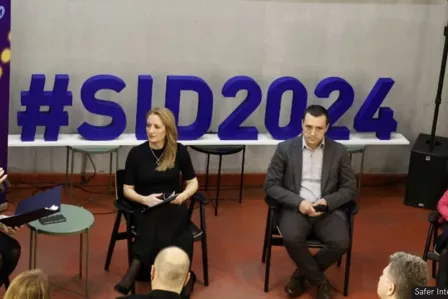This year, Safer Internet Day in Serbia was celebrated with a conference entitled Safety without exception. Mihailo Jovanović, Minister of Information and Telecommunications, and Jaroslaw Ponder, Head of the Office for Europe at the International Telecommunication Union (ITU), opened the conference, which was divided into three panels.

Panel I: Misuse of photographs and grooming by predators - institutional mechanisms
The first panel discussion posed the following questions:
- How do children become victims of recruitment?
- In what ways can children's photos published on social networks be misused?
- What are the penalties for those who create and distribute child pornography?
- What is the difference between sexting and child pornography?
- What are the challenges in gathering evidence regarding these crimes?
Panellists included Mirjana Stajkovac from the Special Prosecutors Office for High-Tech Crime of Serbia; Vladimir Vujić, Head of Service for Combatting Cyber Crime at MOI Republic of Serbia; and Sandra Bakić, an educator with the Safer Internet Centre.
Panel II: Misuse of photographs and grooming by predators - civilian sector
The second panel explored the ways in which children's photos posted on social networks can be abused. Questions posed included:
- Are parents aware of the risks of posting photo albums and videos, and their children live streaming on social networks?
- How do predators connect with children? Is online violence an easy source of income today?
- How many children are victims of human trafficking for online sexual exploitation (cyber dens, sex tourism...)?
- How can artificial intelligence (AI) be abused?
Panellists included Tatjana Macura, representative of the association Mothers are the Law; Ružica Radović, a psychologist at the Center for Missing and Abused Children; and Marija Vukašinović, a representative of NGO ASTRA.
Panel III: Psychological support
The final panel explored how to recognise manipulation online, how to talk to others about online experiences, and how to overcome fear, shame, powerlessness, guilt, and more.
The panellists included Dragana Đurić, psychologist and teachers Irena Mučibabić and Suzana Bumbić. The panel also included a special segment during which internet security was discussed with well-known influencers Marija Radovic and David Pavlović. A particular focus was on hate speech among peers.
Table discussions were organised at the Serbian Safer Internet Day event
The audience for this event included high school students accompanied by professional workers from their schools (teachers, psychologists, and counsellors). An additional webinar for public sector employees, titled Children's safety on the internet, attracted over 500 participants.
Find out more about Safer Internet Day in Serbi via its SID profile page.
This year, Safer Internet Day in Serbia was celebrated with a conference entitled Safety without exception. Mihailo Jovanović, Minister of Information and Telecommunications, and Jaroslaw Ponder, Head of the Office for Europe at the International Telecommunication Union (ITU), opened the conference, which was divided into three panels.

Panel I: Misuse of photographs and grooming by predators - institutional mechanisms
The first panel discussion posed the following questions:
- How do children become victims of recruitment?
- In what ways can children's photos published on social networks be misused?
- What are the penalties for those who create and distribute child pornography?
- What is the difference between sexting and child pornography?
- What are the challenges in gathering evidence regarding these crimes?
Panellists included Mirjana Stajkovac from the Special Prosecutors Office for High-Tech Crime of Serbia; Vladimir Vujić, Head of Service for Combatting Cyber Crime at MOI Republic of Serbia; and Sandra Bakić, an educator with the Safer Internet Centre.
Panel II: Misuse of photographs and grooming by predators - civilian sector
The second panel explored the ways in which children's photos posted on social networks can be abused. Questions posed included:
- Are parents aware of the risks of posting photo albums and videos, and their children live streaming on social networks?
- How do predators connect with children? Is online violence an easy source of income today?
- How many children are victims of human trafficking for online sexual exploitation (cyber dens, sex tourism...)?
- How can artificial intelligence (AI) be abused?
Panellists included Tatjana Macura, representative of the association Mothers are the Law; Ružica Radović, a psychologist at the Center for Missing and Abused Children; and Marija Vukašinović, a representative of NGO ASTRA.
Panel III: Psychological support
The final panel explored how to recognise manipulation online, how to talk to others about online experiences, and how to overcome fear, shame, powerlessness, guilt, and more.
The panellists included Dragana Đurić, psychologist and teachers Irena Mučibabić and Suzana Bumbić. The panel also included a special segment during which internet security was discussed with well-known influencers Marija Radovic and David Pavlović. A particular focus was on hate speech among peers.
Table discussions were organised at the Serbian Safer Internet Day event
The audience for this event included high school students accompanied by professional workers from their schools (teachers, psychologists, and counsellors). An additional webinar for public sector employees, titled Children's safety on the internet, attracted over 500 participants.
Find out more about Safer Internet Day in Serbi via its SID profile page.
- < Previous article
- Next article >










